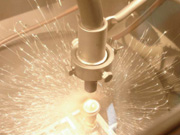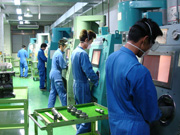 When initially developed, the “WPC” in WPC processing stood for “Wide Peening Cleaning.” However, as major automakers came to use the process, the name “Wonder Process Craft” also came to be used, and this is the name that is now most widely used.
When initially developed, the “WPC” in WPC processing stood for “Wide Peening Cleaning.” However, as major automakers came to use the process, the name “Wonder Process Craft” also came to be used, and this is the name that is now most widely used.
WPC is a surface modification technology for metal products, in which the metal surface is bombarded at high speeds by minute particles that are selected on the basis of the purpose of the treatment and driven by compressed air.
 During the application of this technique, the surface of the material being treated is rapidly heated and cooled, repeatedly. This results in the formation of a fine, dense and extremely tough structure. The process simultaneously increases the hardness of the surface and covers it with tiny dimples that improve the frictional wear characteristic of the material.
During the application of this technique, the surface of the material being treated is rapidly heated and cooled, repeatedly. This results in the formation of a fine, dense and extremely tough structure. The process simultaneously increases the hardness of the surface and covers it with tiny dimples that improve the frictional wear characteristic of the material.
As a result, WPC processing is used as a surface-modifying heat treatment in a wide variety of fields, for example to strengthen and improve the performance of machine parts, cutting tools and dies.
Feature of wpc processing
1:A surface covered with minute micro dimple is created.
2:An extremely thin work-hardening layer is formed.
3:Compressive residual stress peaks close to the surface.
4:The geometry and dimensions of the work piece barely vary.
5:This method is applicable to thin plates, small-diameter parts, and bottleneck portions as well.
6:Various metallic coatings can readily be formed.
7:Inapplicable portions can easily be masked.
8:A variety of high functionality can be achieved at the same time.
9:High convenience allows low cost.
Effects of WPC Processing
1:In addition to increasing surface hardness of metals, increases toughness by refining structure.
2:Microdimpling of the surface increases oil retention, resulting in improved sliding performance.
3:Enables formation of hard films on metal surfaces.
4:Enables formation of high-performance lubricating films.
5:Extends fatigue life.
6:Increases wear resistance, pitching resistance and chipping resistance.
7:Prevents stress corrosion, grain boundary corrosion, electrolytic corrosion, etc.
8:Reduces noise.
9:Corrects blowholes and pinholes in cast products, etc.
10:Increases adhesion of platings, coatings, etc.
11:Use in combination with other treatments such as nitriding and carburizing has a multiplying effect.









